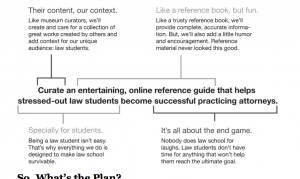 Today’s guest post is written by Lisa Gerber.
Today’s guest post is written by Lisa Gerber.
Despite the fact we all might get writer’s block from time- to-time, there is no shortage of ideas, or places for inspiration for content topics.
But let me ask you this: Do you have a mission for the content you provide?
There are plenty of businesses out there for which finding your mission might seem straightforward.
A winery comes to mind as an example; they can talk about the process of making wine, the grapes, pairing the wine, recipe ideas… and much more.
On the other end of the spectrum is a widget maker – let’s say a manufacturer of electrical paint for transformers. Their market is much more narrow and more difficult to connect with online, than a winery, which would have a much more mainstream audience.
In either situation, there is plenty of content, but it’s important to define the mission.
It is the guiding light for the chaos of your content library. It provides the overarching goal of your inbound marketing strategy, answering the question, “What are we going to be in five years? How are we perceived?”
Your mission guides you throughout the decades. While your topics will evolve because the details of your business do too – as a result of changing technology, legislation, or any number of things – your mission is broad enough that it continues to guide the direction which ultimately leads to customer conversion and retention.
It’s fairly easy to figure out what to include in your content mission.
- Everything starts with the monitoring phase. It’s impossible to make any decisions if you aren’t aware of the digital landscape, the conversations, who is involved, and where they are happening.
- Conduct workshops with key stakeholders from the executive suites to front-line employees, and discover the issues, challenges, and weaknesses. This could be in the form of a survey or a brainstorming session. It depends on your organization and its needs. It doesn’t have to be a big production. You’ll want to know what types of questions, issues, and pain points your customers are experiencing.
- Create an analysis that outlines the who, what, when, and where from the monitoring. We look at the gaps, who is doing what well already, identify possible ambassadors and other opportunities for the inbound marketing. Regarding the mission specifically, this research phase allows us to see where we want to direct the conversation. It’s the strategy statement for the inbound marketing plan.
Write Your Content Mission Statement
I recently found the diagram up above in Content Strategy for the Web by Kristina Halvorson and Melissa Rach. We might have to shamelessly steal this and integrate into our process. The statement is boiled down into one easily remembered phrase, but the pullout text around the outside helps to justify the different pieces, giving the mission statement deeper meaning. It prevents it from just being words on paper, and provides that, “aha…. I-see-what-you-mean” factor.
Your mission means you have a stake in the ground about something. You take a position and lead the charge.
For your content mission, you could:
- Be a champion of a cause; to raise awareness about an issue in your industry. The vision of Spin Sucks is to change the perception of the PR industry so our content mission is to deliver tips, tools,and case studies to help do that.
- Provide a resource that solves a specific pain point for your target customers. One of our clients’ blogs is to help them integrate technology into their jobs and to stay current in trends.
Your content mission is entirely customer-centric. It will address the what, why, and who of your content.
Having an overarching mission is seriously going to help you sleep at night. It’s going to drive much of the decision-making as you progress into your marketing tactics.
It means you now know where people inside your organization should be commenting on blogs. It tells you what types of conversations in which you want to be engaged on social networks. It drives the editorial direction for your blog, and determines the white papers and ebooks that need to be developed, and more.
It makes sense out of the chaos that your content library can become and offers that guidance; “Is this something we should spend time doing?”
What do you think? Do you have a content mission? Care to share it in the comments?